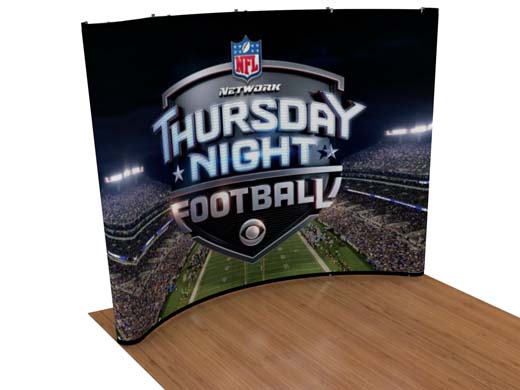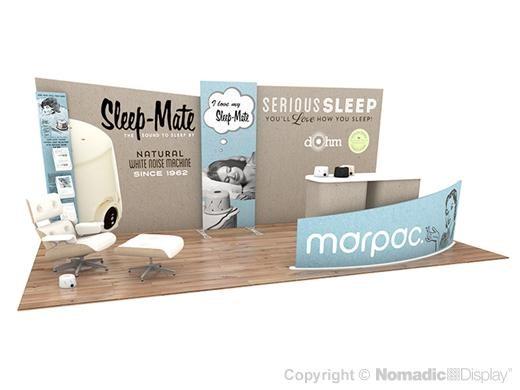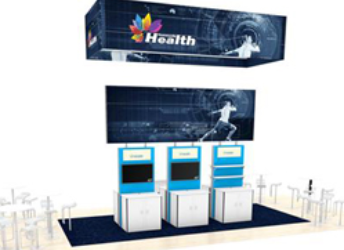How to Keep Your Grip (and Your Sanity) in Check
Fall trade show season is back. I can tell because my inbox looks like a disaster zone and my coffee budget has tripled.
It always starts quietly. You see the first email about shipping deadlines and think, “We’ve got time.” Two weeks later, you’re buried in design proofs, vendor calls, freight paperwork, and a pile of “urgent” requests that are only urgent to the person who sent them.
Meanwhile, Susie from accounting has wandered in with another “quick question” that is not quick and is barely a question.
If you’ve ever hidden in the supply closet with a fun-size Snickers and a thousand-yard stare, you get it. That delicate thing people call work-life balance? It is the goal, but during show season it feels more like a myth your HR manual made up.
Still, it is possible to keep a grip without losing it completely. You just need a game plan—one that’s equal parts practical and ridiculous enough to actually work.
So, every fall feels the same to me. The kids are hauling backpacks back to school and I’m hauling exhibits back on the show floor. Honestly, the prep isn’t all that different. Parents are stocking up on pencils and lunch boxes, and I’m scrambling to make sure graphics, staff, and shipping are all squared away. Both are stressful. Both require coffee. And both come with that one moment where you ask yourself, “Why didn’t I start this earlier?”
Here’s how I see the overlap and where trade show prep can feel a whole lot like the first week of school.
The Prep List That Keeps Me Sane
✔️ Supplies Check
Parents are buying notebooks and glue sticks. For me, it’s graphics, chargers, shipping labels, and the giveaway stash. I’ve learned the hard way that forgetting one cord can turn into a $200 emergency run at the show site. So yes, my “school supply” checklist is non-negotiable.
✔️ Don’t Miss The Bus
Parents worry about bus routes. I worry about freight carriers, install windows, and whether my staff will remember their flight times. One missed detail and the whole plan goes sideways. I’ve started treating logistics like a teacher’s lesson plan: write it out, make copies, and keep one in my back pocket at all times.
✔️ Presentation Counts
New sneakers for the kids, new graphics for me. People notice. If my team shows up in wrinkled polos or our visuals are two years out of date, the message is clear that we’re not ready. A little polish goes a long way toward looking like we belong at the show.
✔️ Homework Isn’t Optional
I nag my kids about finishing their summer reading. Meanwhile, I’m the one cramming before a show, making sure the team knows our talking points, practicing the demo, double-checking the lead capture system. If we don’t prep, it shows. And unlike math homework, there’s no “partial credit” when a show goes off track.
✔️ First-Day Nerves
I’ve seen it in my kids, and I feel it myself before day one of a big show. Did I cover everything? What if traffic is slow? What if the demo crashes? I remind myself what I tell them: you’ve prepared, you’ve got this, and once you settle in, it won’t feel so scary.
✔️ Snack Time Matters
Parents pack snacks so kids don’t crash. I try to do the same for my team. Otherwise, someone vanishes “for coffee” and reappears an hour later with a smoothie. A little planning keeps everyone on the floor when it matters most.
✔️ Notes Home
Teachers send notes home. I send notes everywhere from vendors and show organizers, to even my own team. And after the show? That’s the parent-teacher conference part. Follow-up is where the real work happens, and if I drop the ball there, all that prep was for nothing.
✔️ Budget Reality Check
Parents walk out of back-to-school shopping with lighter wallets. I walk out of a show cycle wondering if the numbers will work. Rentals, shipping, labor, storage. Oh boy. It adds up fast. That’s why I fight for the budget early and look for ways to reuse or reconfigure displays. Otherwise, it’s like buying new school supplies every single week.
Trim the Chaos Before it Eats Lunch with You
Trade show prep will eat every hour you give it. I start with two lists.
List One: the three things that will make this season a win. Book the meetings that matter. Finalize the display so it works for the whole schedule. Lock in a lead follow-up plan that someone will actually use.
List Two: the time-stealers. The fifth revision of the handout no one reads. The “what if we added this” ideas that pop up at 4 p.m. on Friday. The deep dive into which giveaway pen clicks the nicest.
List One gets my attention. List Two gets filed in a folder called “Not Now.”
Sanity Check: If you let everything feel urgent, nothing is actually important.
I once spent a week debating how large our logo needed to be. You know what attendees remembered from that show? The free espresso.
Keep the Crew from Flatlining
The people who make a show happen are not always the ones who stand in the exhibit. Marketing has been pumping out content for months. Design has been living in CAD files. Logistics has been charming freight carriers into meeting deadlines. Procurement has been tracking down giveaways that don’t look like everyone else’s.
If the pre-show crew burns out before the first badge scan, your season starts on the wrong foot.
How I keep the wheels on the bus in motion:
- Schedule real breaks in the run-up. Last-minute all-nighters are not a badge of honor.
- Have a “nothing is too small” meeting. Get every lingering question or fear on the table before show week.
- Rotate point people for vendor calls. Nobody should have to deal with every time zone alone.
- Acknowledge the wins out loud. You don’t need balloons, but you do need to tell people when they’ve saved the day.
Sanity Check: People remember how you made them feel, not just what you asked them to do.
Micro-meltdown prevention tip: I once brought in breakfast sandwiches the week before a big show. Ten minutes later, the whole team was laughing. I’m convinced egg, bacon and cheese wraps are the unsung heroes of morale.
Anchor Yourself Before the Current Pulls You Under
Show season throws you into a different city, a different time zone, and a completely different rhythm. Without small routines, the days blur until you have no idea what day it is.
I build my anchors before the chaos starts:
-
Morning filter: before email, I decide on one win for the day.
-
Post-day jot: three things that worked, three that didn’t. Done in ten minutes, sanity saved.
-
Hard stop: pick a time to close the laptop and mean it.
-
One personal constant: something that reminds you you’re still you. For me, it’s my playlist and my “Minions” coffee mug.
Sanity Check: If you wait for the perfect time to rest, you’ll be waiting until the freight is back in storage.
Travel tip: If you’re traveling with your team, set a rule that at least one dinner is completely show-talk free. It feels weird at first, but by dessert you’ll remember you are actual humans, not just walking to-do lists. We love playing the game Two Truths and Lie.Give it a go!
Stuff I Swear Works (Don’t Ask How I Know)
-
The Booth Buddy System
Pair people up before the show. Your buddy reminds you to eat lunch. You remind them the important client’s name is not Frank.
-
Mystery Snack Diplomacy
Keep a snack in your bag you can trade with another exhibitor. You’ll be amazed how far a peanut butter cookie can get you.
-
The Parking Lot Pact
Step outside with a teammate, say the one thing you can’t say inside, and then go back in like you’re the picture of composure.
-
No-Email Mornings
Once a week during prep, hold email until 10 a.m. Watch how much real work you get done.
-
The 20-Minute Fake Commute
At home or in the hotel, take a quick walk before starting work. It tricks your brain into thinking you have a boundary between life and show prep.
-
The Emergency Mat Liners
Keep a pack for anyone stuck standing for hours. Instant hero status.
-
The Strategic Coffee Drop
Send coffee to a vendor who’s running behind. Amazing how fast things move when you caffeinate the room.
Sanity Check: Survival is a team sport, even if your sport involves carpet swatches and lead scanners.
Your Final Sanity Check
It will stretch your patience and your calendar. It will tempt you to answer emails at midnight and make you question if your phone is surgically attached to your hand.
But if you trim the chaos before it takes over, protect your crew from burning out, and keep your own anchors in place, you’ll get through it without turning into the office legend who snapped mid-season.
And yes, you will probably still end up in the supply closet at some point. That’s totally fine. Just make sure you bring enough mystery snacks to share.
In the classroom or on the show floor, the themes are the same: be prepared, stay flexible, and laugh when things go sideways. I’ve had my share of “forgot the lunchbox” moments, but every season I get a little better at juggling it all.








